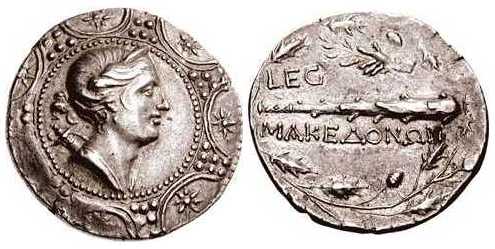| 149 BC - 148 BC |
Ρωμαϊκή Μακεδονία
| Tetradrachm / Τετράδραχμον AR 29 | SHH 1170 |
 |
| Parameter Obverse Reverse Notes Reference |
16.64 g 28.7-29.7 mm 1.6-4.6 mm
3.00
o'clock EF Diademed and draped bust of Artemis right, in circle of dots, bow and quiver over shoulder, in the center of a Macedonian shield decorated with seven eight-pointed stars within double crescents, each separated by seven pellets. LEG // ΜΑΚΕΔΟΝΩΝ above and below club right; hand holding olive brunch left in upper field; all within oak wreath [with thunderbolt to left]. Amphipolis mint. Ex CNG Triton VII/207,10.1.2005;ex Hirsch 33/603, 17.11.1913; ex Rhousopoulos Collection, Hirsch 13/769, 15.5.1905 AMNG III/1 190 (Praetor Juventius Thalma, 149 BC); Ashmolean 3310; BMC Macedonia 69 (after 146 BC); Copenhagen II 1317 (Praetor Juventius Thalma, 149 BC); Dewing ---; Evelpidis II ---; Locket 1540; MacKay Macedonian 6b (O1/R6 this coin); Milano VI/1 ---; Moushmov 5868 (ca. 150 BC) |
| A.M.
Burnett published a hoard ("Aesillas: Two new hoards," CH VII)
containing a small number of these tetradrachms along with various
Athenian new style tetradrachms, Thasos tetradrachms, and Aesillas
tetradrachms. Due to the light wear on the LEG MAKEDONWN tetradrachms,
Burnett concluded that they were struck shortly before Aesillas'
issues, a downdating of approximately fifty years. Some numismatists
have adopted this proposal (see Crawford, CMRR, pg. 197). It seems more
likely, however, that any apparent anomaly in degree of wear can be
explained by the possibility that the hoard was assembled over a period
of time, a supposition also supported by the other coinage found in the
hoard. For example, the Athenian issues span the years 159/8-137/6 BC,
and a number of these are also as well preserved as the Macedonian
coins. The evidence of this single find is thus inconclusive, and
cannot override MacKay's analysis without further confirmation [CNG]. |